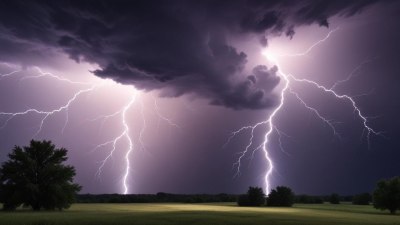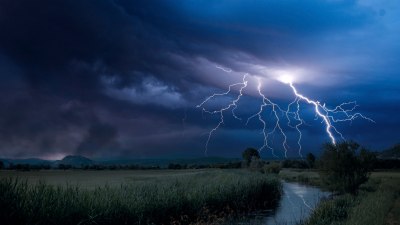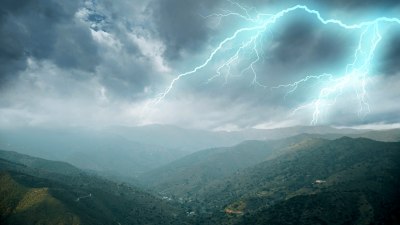The Longest-Lasting Thunderstorms in History
Explore the most remarkable thunderstorms that have lasted the longest, their features, and impacts.

This image was created with the assistance of Freepik
Thunderstorms are fascinating meteorological phenomena that can unleash intense rain, powerful winds, and striking lightning. Among these storms, some have remarkably extended durations, leading to significant weather events that leave lasting impressions. In this article, we delve into some of the longest-lasting thunderstorms on record, examining their characteristics, impacts, and the science behind their persistence.
Understanding Thunderstorms
Thunderstorms form when moist, warm air rises and cools, leading to the condensation of water vapor and the release of latent heat. This process creates unstable conditions in the atmosphere, promoting the development of cumulonimbus clouds, which can produce heavy rain, winds exceeding 50 mph, and often, severe lightning strikes. However, not all thunderstorms are created equal; some have unique attributes that allow them to last longer than usual.
The Criteria for Measuring Duration
The duration of a thunderstorm can be measured based on its continuous activity, including rain, lightning, and wind. Meteorologists identify sustained thunderstorm activity through radar tracking, satellite imagery, and ground reports. Typically, a storm must maintain these elements over a span of time, often recorded in hours or even days, to be classified among the longest-lasting storms.
Historic Long-Lasting Thunderstorms
Several thunderstorms throughout history have set records for their remarkable duration. Here are some notable examples:
The Thunderstorm of 10-11 January 1973
One of the longest-lasting thunderstorms occurred in the vicinity of the Gulf Coast, particularly affecting areas of Mississippi and Alabama. This storm produced unrelenting rainfall for over 36 hours, resulting in significant flooding. Meteorologists attributed its longevity to a combination of warm moist air from the Gulf of Mexico and a stationary front that refused to move, allowing the thunderstorm to persist with little interruption.
The Great Storm of 1969
Occurring from November 11 to November 15, 1969, this storm system impacted the Caribbean and southeastern United States. It lasted for more than 40 hours, unleashing torrential rains and severe lightning across several states. The atmospheric conditions were characterized by upper-level disturbances that maintained the thunderstorm’s development. The storm left behind considerable property damage, as well as schools and businesses closing due to unsafe conditions.
The 1999 Birmingham Thunderstorm
In July 1999, the city of Birmingham, England experienced a significant thunderstorm that lasted well over 24 hours, setting records for intensity and duration in the area. The storm brought heavy rain and winds up to 60 mph, resulting in widespread disruption, flooding, and power outages. The persistence of this storm was attributed to an unusual weather pattern that trapped moisture and energy over the region, enabling long-lasting downpours.
Long-Lasting Thunderstorms in South America
While the United States often garners attention for its thunderstorm activity, South America cannot be overlooked. For instance, a notable case occurred in the Amazon rainforest region, where thunderstorms can last several days due to the high humidity and warmth of the area combined with local geographical features. These storms are essential for the rainforest ecosystem, providing vital rainfall in a predominantly dry climate.
The Science Behind Their Longevity
Understanding why some thunderstorms last longer than others involves analyzing various atmospheric factors. Key elements include moisture availability, temperature gradients, and wind patterns. When warm, moist air ascends rapidly, it can fuel a thunderstorm, but conditions must also remain favorable for the storm to sustain itself. For instance, the presence of a stationary front can allow continued uplift and development of the thunderstorm.
Impact of Long-Lasting Thunderstorms
Long-lasting thunderstorms can cause both positive and negative effects on the environment and society. While they can lead to beneficial rainfall in agricultural areas, they also pose significant risks. Flooding can result from excessive rainfall, particularly in urban areas where drainage systems may be overwhelmed. Additionally, the strong winds and lightning associated with thunderstorms can damage infrastructure, trees, and power lines, causing widespread disruption, and sometimes even injuries.
Lightning Strikes and Their Danger
One of the most hazardous aspects of thunderstorms is lightning. As a storm persists, the chances of lightning strikes increase, which can lead to wildfires, injuries, and fatalities. In fact, lightning is a leading cause of weather-related deaths in many regions around the world. Understanding how to stay safe during a thunderstorm is crucial, especially during those that last several hours or more.
Preparing for Long-Lasting Thunderstorms
Being prepared for the possibility of long-lasting thunderstorms involves having a safety plan in place. Monitoring weather updates through local news or apps can help individuals stay informed about storm developments. Building an emergency kit with essentials like water, food, flashlights, and first aid supplies is also advisable in case of prolonged thunderstorms that might lead to power outages and flooding. Practicing what to do during a thunderstorm, including seeking shelter, can save lives.
The Future of Thunderstorms
As climate change continues to reshape weather patterns, the frequency and intensity of thunderstorms may also change. While it remains uncertain how these shifts will affect the duration of thunderstorms, many scientists agree that warmer temperatures could lead to an increase in moisture and potentially more severe thunderstorm activity. Understanding these trends is essential for adapting infrastructure and public safety measures.
Long-lasting thunderstorms illustrate the dynamic and complex nature of our atmosphere. These storms have shaped landscapes, ecosystems, and communities throughout history. By studying these remarkable phenomena, we gain valuable insights into weather patterns and the necessary steps to prepare for their ramifications. As we continue to advance our understanding of meteorology and atmospheric science, we can better equip ourselves to face the challenges posed by extreme weather events, including those iconic thunderstorms that seem to stretch on endlessly.











